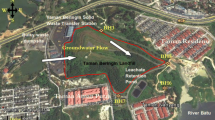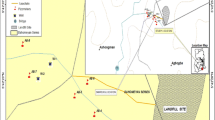Abstract
Hazaribagh is a densely populated area of Dhaka city where about 185 leather processing industries have been operating and discharging solid and liquid wastes directly to the low-lying areas, river and natural canals without proper treatment. The area is covered by alluvial deposits of Holocene age and is underlain by Pleistocene Madhupur clay. The Dupi Tila Formation of Mio-Pliocene age underlain by this yellowish gray to brick red clay bed serves as the main water-bearing aquifer of Dhaka city. To assess the environmental degradation as well as the groundwater environment, major anions, cations and heavy metals of water samples, heavy metals and organic carbon content of sediment samples were analyzed in this study. Analyses of tannery effluent detect high concentration of Na+, Mg2+, Cl− and SO 2−4 followed by Ca2+, NH +4 and K+ with remarkable contents of some trace elements, mainly Cr, Fe, Mn, S, Ni and Pb. Higher accumulations of Cr, Al and Fe are observed in topsoil samples with significant amounts of Mn, Zn, Ni and Cu. Concentrations of ions and all the investigated trace elements of sampled groundwater were within the maximum allowable limit for drinking water of the Department of Environment, Bangladesh (DoE), and World Health Organization (WHO). However, excessive concentrations of Cr, Pb, etc., have already been reported in the shallow groundwater (10–20 m) of the area. Due to excessive withdrawal the vulnerability of groundwater contamination in deeper parts cannot be avoided for the future.





Similar content being viewed by others
References
Ahmed KM, Hasan MA, Sharif SU, Hossain KS (1998) Effect of urbanization on groundwater regime, Dhaka city, Bangladesh. J Geol Soc India 52:229–238
Appelo CAJ, Postma D (1999) Geochemistry, groundwater and pollution. A.A. Balkema, Rotterdam, 535 pp
Bopp LH, Ehrlich HL (1988) Chromate resistance and reduction in pseudomonas fluorescens strain LB 300. Arch Microbiol 150:426–431
Brammer H (1996) The geography of the soils of Bangladesh. University Press Limited, Dhaka
BWDB (2003) Ground Water Processing Branch Data Centre, Bangladesh Water Development Board, Dhaka, Bangladesh
DoE (1997) Environment Conservation Act, the Government of Bangladesh, 48 pp
Domenico PA, Schwartz FW (1997) Physical and chemical hydrogeology. Wiley, New York, 506 pp
DWASA (1991) Dhaka region groundwater and subsidence study. Final report, vol 2. Water Supply and Sanitation Urgent Expansion Project, Bangladesh
Fetter CW (1994) Applied hydrogeology. Prentice Hall, New Jersey, 691 pp
Hounslow AW (1995) Water quality data—analysis and interpretation. Lewis Publishers, New York, 397 pp
Johnson CA, Sigg L, Lindauer U (1992) The chromium cycle in a seasonally anoxic lake. Limnol Oceanogr 37:315–321
Kotas J, Stasicka Z (2000) Chromium occurrence in the environment and methods on its speciations. Environ Pollut 107:263–283
Losi ME, Amrhein C, Frankenberger WT Jr (1994) Bioremediation of chromate contaminated groundwater by reduction and precipitation in surface soils. Environ Toxicol Chem 13:1727–1735
Lovley DR (1993) Dissimilatory metal reduction. Annu Rev Microbiol 47:263–290
Mitchell J (1932) The origin, nature and importance of soil organic constituents having base exchange properties. J Am Soc Agron 24:256–275
Nairuzzaman M, Haque ME, Rahman MJJ (2000) Influence of clay minerals on consolidation behavior of Madhupur clay: a case study from some samples of greater Dhaka city. Bangladesh Geosci J 6:135–142
Oliver DS, Brockman FS, Bowman RS, Kieft T (2003) Microbial reduction of hexavalent chromium under vadose zone conditions. J Environ Qual 32:317–324
Perez-Benito JF, Arias L (2001) The pyrophosphate assisted reduction of chromium (VI) by manganese (II) and its reverse reaction. New J Chem 25:1438–1446
Richard FC, Bourg ACM (1991) Aqueous geochemistry of chromium. J Water Res 25:807–816
Saha GC (2001) Assessment of groundwater contamination in Dhaka city from tannery waste. M.Sc. thesis (unpublished), BUET, 100 pp
Sharif MS (1999) Urban and industrial pollution to ground water of the southern part of Dhaka city. M.Sc. thesis (unpublished), University of Dhaka, 144 pp
Shen H, Wang WT (1993) Characterization of enzymatic reduction of chromium by Escherichia coli. J Environ Eng 120:560–572
Stewart MA, Jardine PM, Barnett MO, Mehlhorn TL, Hyder LK, Mckay LD (2003) Influence in soil geochemical and physical properties on the sorption and bioaccessibility of chromium (III). J Environ Qual 32:129–137
UNIDO (2000) Regional programme for pollution control in the tanning industry in south-east Asia: chrome balance in leather processing
UNIDO-GoB (2000) Environmental impact assessment (EIA) on the industrial activities at Hazaribagh area, Dhaka. Final report, project-US/BAS/97/137-EIA
Wang PC, Mori T, Komori K, Sasatsu M Toda K, Ohatake H (1989) Isolation and characterization of an enterobacter cloacae strain that reduces hexavalent chromium under anaerobic conditions. Appl Environ Microbiol 55:1665–1669
Wentink GR, Etzel JE (1972) Removal of metal ions by soil. J Water Pollut Control Fed 44:1561–1574
WHO (1993) Guideline for drinking water quality, vol 1, 2nd edn. Recommendations: World Health Organization, 188 pp
Acknowledgement
The authors would like to thank Dr. Jorn Breuer, Institute of Agricultural Chemistry, University of Hohenheim, Mrs. Renate Riehle and Mrs. Anne Hartmann-Renz, Institute for Geology and Paleontology, University of Tuebingen, for their good support in the respective laboratories in Germany performing hydro and geochemical analyses. This study was funded by the German Academic Exchange Service (DAAD).
Author information
Authors and Affiliations
Corresponding author
Rights and permissions
About this article
Cite this article
Zahid, A., Balke, K.D., Hassan, M.Q. et al. Evaluation of aquifer environment under Hazaribagh leather processing zone of Dhaka city. Environ Geol 50, 495–504 (2006). https://doi.org/10.1007/s00254-006-0225-1
Received:
Accepted:
Published:
Issue Date:
DOI: https://doi.org/10.1007/s00254-006-0225-1




